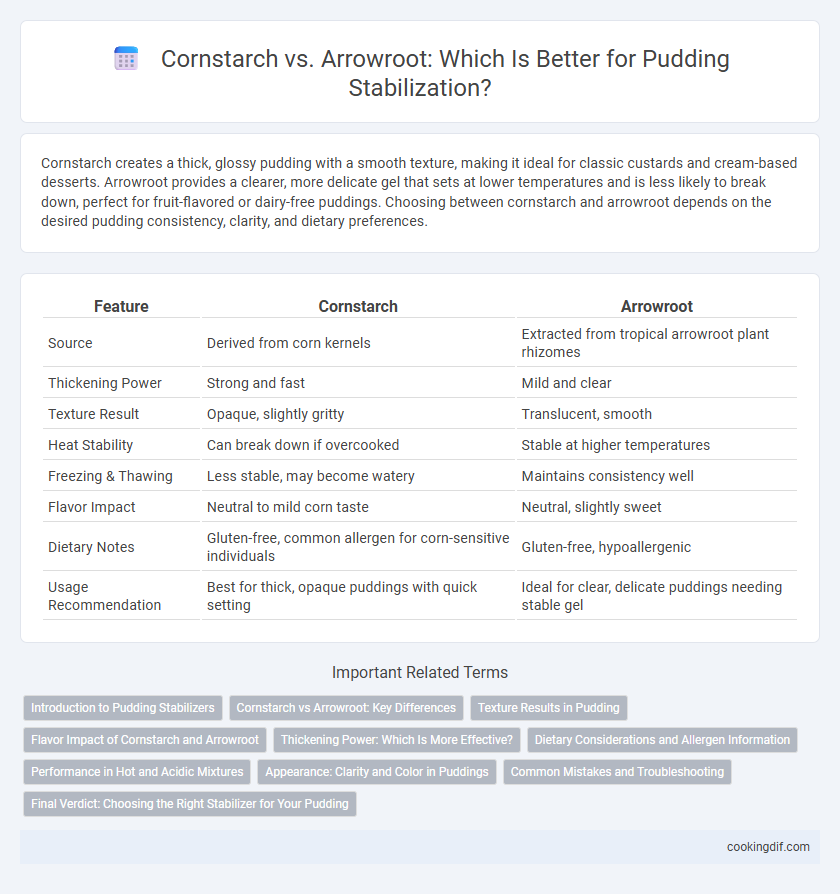Cornstarch creates a thick, glossy pudding with a smooth texture, making it ideal for classic custards and cream-based desserts. Arrowroot provides a clearer, more delicate gel that sets at lower temperatures and is less likely to break down, perfect for fruit-flavored or dairy-free puddings. Choosing between cornstarch and arrowroot depends on the desired pudding consistency, clarity, and dietary preferences.
Table of Comparison
| Feature | Cornstarch | Arrowroot |
|---|---|---|
| Source | Derived from corn kernels | Extracted from tropical arrowroot plant rhizomes |
| Thickening Power | Strong and fast | Mild and clear |
| Texture Result | Opaque, slightly gritty | Translucent, smooth |
| Heat Stability | Can break down if overcooked | Stable at higher temperatures |
| Freezing & Thawing | Less stable, may become watery | Maintains consistency well |
| Flavor Impact | Neutral to mild corn taste | Neutral, slightly sweet |
| Dietary Notes | Gluten-free, common allergen for corn-sensitive individuals | Gluten-free, hypoallergenic |
| Usage Recommendation | Best for thick, opaque puddings with quick setting | Ideal for clear, delicate puddings needing stable gel |
Introduction to Pudding Stabilizers
Cornstarch and arrowroot serve as primary pudding stabilizers, each offering distinct thickening properties and textures. Cornstarch creates a smooth, glossy finish with a slightly denser consistency, while arrowroot yields a clearer, silkier pudding ideal for delicate flavors. Choosing between these thickeners depends on the desired pudding texture, clarity, and compatibility with acidic ingredients.
Cornstarch vs Arrowroot: Key Differences
Cornstarch and arrowroot are both common thickeners used in pudding, but they differ significantly in texture and cooking properties. Cornstarch creates a smooth, glossy finish with a slightly heavier texture and requires higher temperatures to activate, making it ideal for traditional custard-style puddings. Arrowroot produces a clearer, more translucent gel with a lighter mouthfeel and remains stable even when frozen or reheated, making it preferable for delicate or fruit-based puddings.
Texture Results in Pudding
Cornstarch creates a creamy, dense texture in pudding due to its high amylopectin content, which gels firmly upon cooling. Arrowroot produces a smoother, silkier consistency with a translucent appearance, offering a lighter mouthfeel. The choice between cornstarch and arrowroot directly influences the pudding's thickness, clarity, and overall texture profile.
Flavor Impact of Cornstarch and Arrowroot
Cornstarch imparts a slightly more neutral and creamy texture to pudding, often enhancing its smoothness without altering the flavor profile significantly. Arrowroot provides a more delicate and glossy finish, contributing a subtle sweetness that can brighten the overall taste of the pudding. The choice between cornstarch and arrowroot affects not only the pudding's texture but also its flavor complexity, with arrowroot offering a lighter, less starchy taste compared to cornstarch.
Thickening Power: Which Is More Effective?
Cornstarch exhibits stronger thickening power compared to arrowroot, making it more effective for creating a dense, stable pudding texture. Arrowroot provides a clearer, glossier finish but requires larger quantities to achieve similar thickening results. For optimal pudding stabilization, cornstarch is preferred due to its superior gelatinization properties at lower temperatures.
Dietary Considerations and Allergen Information
Cornstarch is a common thickening agent in pudding but may contain gluten traces, making it unsuitable for those with celiac disease or gluten sensitivities. Arrowroot is a gluten-free alternative derived from tropical plant roots, often preferred for allergen-sensitive or paleo diets. Both starches provide effective pudding stabilization, but arrowroot offers a hypoallergenic option with a neutral flavor and clearer texture.
Performance in Hot and Acidic Mixtures
Cornstarch thickens puddings effectively but can break down under prolonged heat and acidic conditions, leading to a thinner consistency. Arrowroot maintains stability and clarity in hot and acidic mixtures, providing a smoother texture without becoming cloudy or losing its gelling power. For acidic fruit-based puddings or recipes requiring extended cooking times, arrowroot is the superior stabilizer for consistent performance.
Appearance: Clarity and Color in Puddings
Arrowroot imparts a clearer, glossier appearance to puddings compared to cornstarch, which tends to produce a more opaque and slightly cloudy finish. The neutral color of arrowroot preserves the vibrant hues of fruit-based or infused puddings, while cornstarch may impart a faint white tint. For desserts where visual appeal and translucency are critical, arrowroot offers superior clarity and bright color retention.
Common Mistakes and Troubleshooting
Using cornstarch instead of arrowroot in pudding can result in a cloudy appearance and a slightly gummy texture due to cornstarch's tendency to break down under prolonged heat. Arrowroot provides a clearer, silkier finish and remains stable when frozen, unlike cornstarch which can become watery after thawing. A common mistake is overcooking cornstarch-thickened puddings, causing them to lose their thickening power; to troubleshoot, gently heat and avoid boiling to maintain pudding consistency.
Final Verdict: Choosing the Right Stabilizer for Your Pudding
Cornstarch provides a thick, creamy texture ideal for traditional puddings, offering strong stabilization and clarity. Arrowroot creates a lighter, glossy finish with better freeze-thaw stability, making it perfect for delicate or fruit-based puddings. Choose cornstarch for robust, classic pudding consistency, and arrowroot for a smoother, more translucent dessert with superior freeze resilience.
Cornstarch vs arrowroot for pudding stabilization Infographic

 cookingdif.com
cookingdif.com